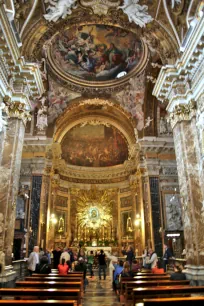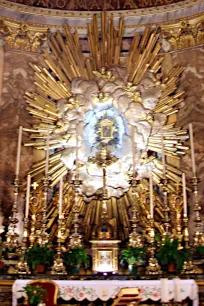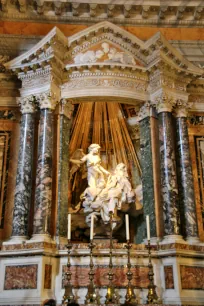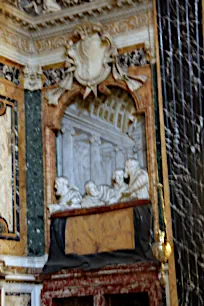Santa Maria della Vittoria is a small, intimate church situated on Piazza San Bernardo, opposite the Fountain of Moses. The Baroque church is best known for ‘The Ecstasy of Teresa’, one of Bernini’s most dramatic works.


The church of Santa Maria della Vittoria is quintessential Baroque. The interior is overwhelming, and to modern eyes the abundance of decoration can seem extravagant. No surface is left undecorated: everywhere you look you see colorful pilasters and columns, gilded stucco, marble reliefs, dynamic statues and vibrant paintings.
The church was built between 1608 and 1620 to a design by Carlo Maderno for cardinal Scipione Borghese. The facade was built later, in 1626, by Giovanni Battista Soria.
The Victorious Mary
The church was originally dedicated to Saint Paul. In 1622, two years after the Catholics defeated the Bohemian army at White Mountain, the church was dedicated to Mary and renamed Saint Mary of Victory to commemorate this decisive victory during the Thirty Years’ War.



The victory over the protestant Bohemians was attributed to a small statue of Mary that, Catholics claimed, assisted Emperor Ferdinand in his victory over the army of Frederick V. When the statue was later discovered in the ruins of a castle in Plzeň, it was brought here. In 1833 the statue was destroyed in a fire and replaced with a replica that is now above the altar, surrounded by a cloud and radiating gilded sun rays.
The Ecstasy of Teresa
The church was part of a convent of the Carmelites, an order that was reformed by the Spanish saint Teresa of Avila. Teresa was a prominent figure of the counter-reformation.
The saint is commemorated in the Cornaro Chapel, the last chapel on the left side of the church. The chapel was built in the mid-sixteenth century on behalf of cardinal Federigo Cornaro. In 1645-1652, the great Bernini created a marble sculpture group for the chapel, entitled ‘The Ecstasy of Teresa’. Bernini records a scene that was described by Teresa in her memoirs. In a particular passage, Teresa claims to have had a vision in which a beautiful angel appeared to her and pierced her with a golden arrow.
Bernini’s carving of Teresa and the angel on a cloud is one of his most memorable works. Despite its massiveness, the marble piece seems light and floating. On the left and right side, Bernini created balconies with four figures that are observing and commenting on the spectacle that unfolds below, as if they were in a theater. The figures are of cardinal Cornaro and members of his family.
The depiction of Teresa and the angel is quite disturbing. Teresa seems to be moaning in ecstasy from pain while a smiling angel prepares to pierce her for a second time. Bernini’s graphic image of the violence described by Teresa was – and still is – very controversial.
At the time, conservative Catholics called for the destruction of the marble piece, since they considered it too voluptuous. Today, it is still criticized for its glorification of physical pain; in the Middle Ages, some saw extreme physical pain as a way to follow in the footsteps of Christ. But regardless of the controversy surrounding its subject, Bernini’s sculpture of Teresa is an absolute highlight of Baroque art and one of the must-sees in Rome for art lovers.

